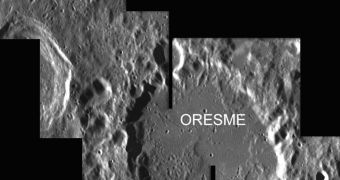Astronomers have obtained a new image showing another evidence of the heavy bombardment the Moon was subjected to. It's a picture of Oresme, a crater located at the South Pole of the Moon, on the far side, at 42.3? South and 169? East, having a diameter of 76 kilometers, measured from north to south.
It has a crooked and bumpy outer rim, and a flat interior, a nearly featureless surface that is marked only by a few tiny craterlets. Its neighbors are the Von Karman crater, significantly larger, at the east-southeast, the Chretien crater to the southwest and Mare Ingenii at the northwest.
The new image was taken by ESA's SMART-1 spacecraft, which has the Advanced Moon Imaging Experiment (AMIE) on board, a highly sensitive camera, only 4 days before SMART-1's final impact on the lunar surface. It shows 110 meters per pixel and has been taken from 1100 kilometers above the surface.
The crater is named after physicist and astronomer Nicolas Oresme (1323 -1382), one of the most famous and influential philosophers of the later Middle Ages. It formed around four billion years ago, and it's a giant impact basin resulting from the collision with a relatively large asteroid, sometime in the Nectarian age, a period in the formation of the Moon.
"Some theoreticians believe that this bombardment period was caused by comets perturbed by the formation of Uranus and Neptune, while others interpret it as leftover from a population of planet embryos on highly inclined orbits or main belt asteroids" says SMART-1 Project scientist Bernard Foing.
"The lunar surface is a history book where we can study scars from this bombardment. It can teach us not only about the accretion processes that formed rocky planets, but also about the effects of collisions during the period of emergence of life on Earth".

 14 DAY TRIAL //
14 DAY TRIAL //